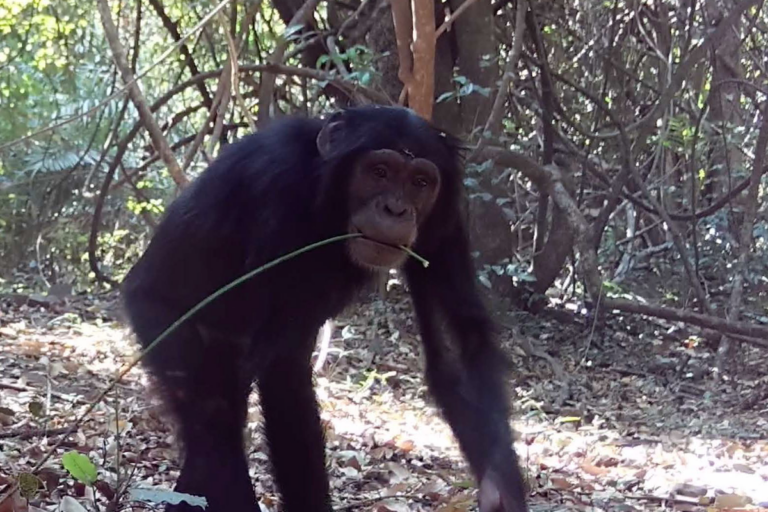- Multiple studies have indicated that wild chimpanzees rely on memory to find ripe fruit, but less has been known about what role memory plays in sourcing foods of animal origin.
- A recent study monitored ant-feeding behaviors in savanna chimpanzees in Senegal, concluding that the apes also rely on memory to locate underground ant nests, rather than simply stumbling across nests opportunistically.
- The chimpanzees were also observed using tools and multiple senses to determine whether ant nesting sites were inhabited.
Wild chimpanzees have long been known to rely on their powerful memories to know where and in what trees they can find ripe wild fruit.
Less has been understood about whether and how the great apes use their memory to locate foods of animal origin, such as army ants, which are known to be rich in nutrients essential for chimpanzees.
Now, a study published in the journal Nature has found that wild chimpanzees (Pan troglodytes) can remember the location of hidden underground ant nests for years, and will repeatedly return to nest sites.
The study presents the first evidence that wild chimpanzees find insects to feed on using the power of memory, not just opportunistically. It’s also the first to describe how chimpanzees use sight, touch, smell and taste to inspect unoccupied nests and detect if there are ants.
“We realised that the fact that the chimpanzees in our study were going back to the same ant nests, even though these were almost never visible, was really important because it suggested that their repeated ant nest visits were not opportunistic, but rather that the chimpanzees relied on their memory to find the nests and revisit them over and over again,” says study co-author R. Adriana Hernandez-Aguilar.

In the study, Hernandez-Aguilar and Andreu Sánchez-Megías, both from the University of Barcelona’s Faculty of Psychology and the Jane Goodall Institute Spain, and seven other researchers monitored the ant-feeding behaviors of chimpanzees in Dindefelo Community Nature Reserve, a savanna habitat in Senegal.
At the time of the research, the Jane Goodall Institute Spain (JGIS) had been studying chimps in the reserve for more than 15 years. Camera trap footage and tools chimpanzees left during food foraging indicated that the primates had been extracting army ants from the same nests over the years.
“Thus, we decided to study the strategies that these apes use to find the ants,” Hernandez-Aguilar tells Mongabay. The researchers wanted to understand whether chimpanzees made use of their memory to revisit known ant nests or if they just stumbled on the nests.
The also analyzed which senses and tool-use tricks the chimpanzees used to detect ants inside the nests.

Using camera traps, they recorded 679 chimpanzee visits to four nests over a period of five years (2018-2022). They found that out of 34 identified chimpanzees who visited the nests, 23 revisited at least once.
Further, chimpanzees visited nest sites significantly more often than similar sites without nests. Individual chimps returned sooner and inspected longer the nests where they found ants during their last visit.
“The results of our study suggest that Dindefelo chimpanzees use two types of memory to consume army ants: spatial memory to remember the exact location of concealed army ant nests and revisit them, and episodic-like memory to remember the presence or absence of ants in each visit to an ant nest to adjust their ant-searching effort at that specific nest accordingly,” Hernandez-Aguilar says.
The study also found that alongside probing tools, the apes used sight, smell, taste and touch to detect availability of ants in the nests. For example, they would remove obstacles blocking the nest entrance using their hands and bring their faces close to the entrance for inspection.
After inserting a tool or introducing a hand into the nest, the apes would inspect them visually, bring them close to their nose, or put them into their mouth.
The findings pave the way for future studies to investigate the evolution of cognitive capacities in primates linked to insect consumption, “something overlooked in previous research,” Hernandez-Aguilar says.
They also have implications for conservation of chimpanzees, of which the western subspecies found in Senegal, P. t. verus, is classified as critically endangered on the IUCN Red List.
These chimpanzees live in open, dry and seasonal habitats where animal protein is hard to find, making ants a particularly vital food source. “In the specific case of Dindefelo, knowing that army ants are an important resource for the chimpanzees, and the locations where this food source can be found, allows the JGIS to direct our conservation efforts to protect the areas where ant nests exist,” Hernandez-Aguilar says.
The study found that army ant nests at the reserve are concentrated along gallery forests — tree corridors along rivers and wetlands — which are also vital habitats for chimpanzees and other species.
“If the army ant–chimpanzee interaction we documented in Dindefelo occurs in other savanna sites in West Africa, gallery forests should be considered even more important areas of conservation for wild chimpanzees, not only for the key fruit species they provide, but also for the insects the apes extract there,” Hernandez-Aguilar says.

Dennis Ndeloh Etiendem, a Cameroonian primatologist who wasn’t involved in the study, says such findings make irrefutable previous research and local people’s accounts demonstrating that chimps have a sophisticated and efficient system of resource mapping allowing them to survive in habitats with sparse resources.
However, Etiendem says he’s pessimistic about whether such research can really drive action to protect apes. “I do not think we need any more findings about the cognitive abilities of chimpanzees,” he says. “It seems that the more we unravel their uniqueness and understand how closely related they are to us, the more endangered they become.”
He adds that despite pockets of chimpanzees enjoying protection, the overall outlook continues to worsen.
The gains that a global push to protect chimpanzees and other great apes from extinction made 20 years ago have been lost as attention turns elsewhere, he says, arguing that political will among governments of habitat states to protect great apes has also disappeared “as the demand for forest land for mineral exploitation, palm and cocoa plantations, and other habitat conversion activities increases.”
“I am sorry to be so pessimistic in my assessment. That is the simple truth,” Etiendem says.
He suggests the world’s failure to protect chimpanzees also spells doom for other wildlife.
“If we cannot halt the disappearance of the creatures most closely related to us,” he says, “what hope is there for wildlife anywhere on the planet?”
Bonobos and chimps recall friends and family even after years apart: Study
Citations:
- Janmaat, K. R. L., Ban, S. D., & Boesch, C. (2013). Chimpanzees use long-term spatial memory to monitor large fruit trees and remember feeding experiences across seasons. Animal Behaviour, 86(6), 1183-1205. doi:10.1016/j.anbehav.2013.09.021
- Normand, E., Ban, S. D., & Boesch, C. (2009). Forest chimpanzees (Pan troglodytes verus) remember the location of numerous fruit trees. Animal Cognition, 12(6), 797-807. doi:10.1007/s10071-009-0239-7
- Sánchez-Megías, A., Galán-Plana, C. F., Mirghani, N., Dotras, L., Galbany, J., Llana, M., … Hernandez-Aguilar, R. A. (2024). Wild chimpanzees remember and revisit concealed, underground army ant nest locations throughout multiple years. Communications Biology, 7(1). doi:10.1038/s42003-024-07206-1
FEEDBACK: Use this form to send a message to the author of this post. If you want to post a public comment, you can do that at the bottom of the page.








